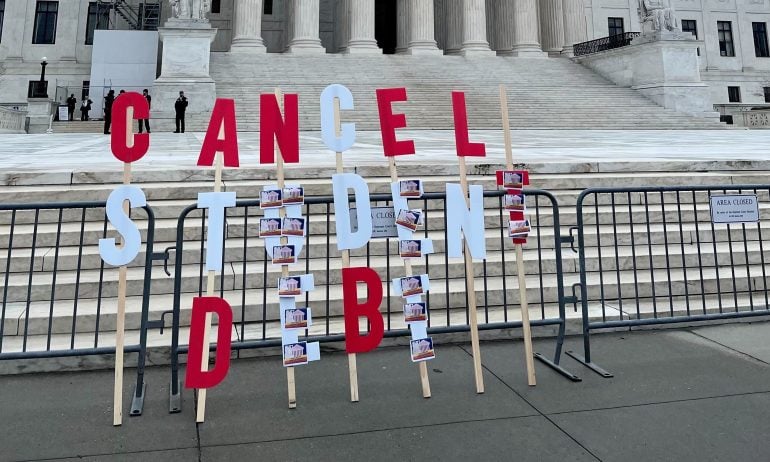Biden Student Loan Forgiveness: Plan ‘B’ Relief Could Reach Millions This Fall, But It’s Not Certain Yet

Many or all of the products featured here are from our partners who compensate us. This influences which products we write about and where and how the product appears on a page. However, this does not influence our evaluations. Our opinions are our own. Here is a list of our partners and here's how we make money.
President Joe Biden has forgiven $153 billion in student debt for 4.3 million borrowers.
25 million could get interest balances reduced under Biden's relief 'plan B', which could debut in fall 2024.
Get student loan relief sooner by enrolling in the new income-driven repayment plan, SAVE.
On April 8, 2024, President Joe Biden shared new details of a ‘plan B' of the broad student debt cancellation plan struck down by the Supreme Court in June 2023.
The new plan primarily benefits borrowers by reducing or eliminating the interest that can make student loan balances balloon. It would fully eliminate accrued interest for 23 million borrowers who owe more than they originally borrowed; two million additional borrowers would see their interest balances reduced. The proposal would also forgive debt for borrowers facing financial hardships, like expensive childcare or healthcare. In tandem with existing forgiveness programs, the plan would help erase four million borrowers’ total debt, the White House said.
“It’s for the good of our economy,” Biden said at a press conference held in Madison, Wisconsin on April 8. “By freeing millions of Americans from student debt, it means they can finally get on with their lives, instead of their lives being put on hold.”
The president said the new relief plan could be in place by this fall, though an exact timeline remains unclear. The plan is not yet finalized, and legal challenges could delay or derail its implementation.
Even without this plan B, the White House has already erased $153 billion in debt for 4.3 million borrowers who qualify for existing student loan forgiveness programs, as of April 12.
That forgiveness tally includes:
$62.8 billion for 876,000 Public Service Loan Forgiveness (PSLF) borrowers.
$49.2 billion for 996,000 longtime borrowers through the IDR account adjustment.
$4.8 billion for 360,000 borrowers enrolled in the SAVE plan.
$22.5 billion for 1.3 million borrowers eligible for borrower defense or closed school discharges.
$14.1 billion for 548,000 borrowers with a total and permanent disability.
Here are the key details of Biden’s newest plan to cancel student debt, and why you shouldn’t count on it just yet.
Biden's student loan forgiveness 'plan B' would be more targeted
Fewer would qualify for relief under plan B, which the Biden administration has been working on since last summer. The plan has stricter eligibility criteria to target the most vulnerable borrowers. Around 10 million borrowers would qualify for at least $5,000 in relief.
By contrast, 43 million borrowers were eligible to get at least $10,000 in relief through Biden’s original relief plan.
Under the latest version of the proposal, announced April 8, these groups of borrowers stand to get partial or full student loan forgiveness:
Borrowers with balances greater than what they originally borrowed. If the interest on your loan grew to be larger than your principal balance, the government would erase up to $20,000 above what you originally borrowed, regardless of your income. If your income is up to $120,000 as an individual or up to $240,000 as a married couple, your entire unpaid interest balance would be forgiven — if you enroll in an income-driven repayment (IDR) plan like SAVE. This relief would be automatic, as long as you qualify. Up to 25 million borrowers could get some relief under this section of the proposal, and 23 million could have their entire balance growth erased.
Borrowers who’ve been in repayment for at least 20 or 25 years. Your remaining balance would be erased if you took out your undergraduate student loans on or before Jul. 1, 2005 and your graduate loans on or before Jul. 1, 2000. Direct Loans and Direct Consolidation Loans would be eligible. More than 2.5 million borrowers have held student loans for 20 years or longer, 1 million of which have already been approved for loan forgiveness via the one-time IDR account adjustment.
Borrowers who attend programs that did not provide sufficient financial value. If your university or program lost eligibility to participate in the Federal Student Aid program, was denied recertification because it misled students or closed, or left you no better off financially than someone with a high school diploma, your student debt would be forgiven.
Borrowers who never applied to other relief programs for which they’re eligible. If you’re eligible for targeted loan forgiveness programs like Public Service Loan Forgiveness (PSLF), could have reached the loan forgiveness threshold for an IDR plan or are eligible for forgiveness through closed school discharge, you’d still get your relief even if you never applied for these programs. Forgiveness amounts would depend on the terms of the program for which you’re eligible. This part of the plan would erase student debt for around 2 million borrowers.
Borrowers who are experiencing financial hardship. If you are considered high risk for default, you would be eligible for automatic cancellation. Those who have high debt and expenses, like childcare and healthcare costs, may also be considered. “Millions” would benefit from this rule, the White House said. This relief may involve an application.
Higher Education Act justifies plan B
The White House is leveraging the Higher Education Act, or HEA, to push plan B forward. The 1965 legislation laid the foundation of the modern U.S. college funding system. It established and governs grants, federal loans and other programs to help students pay for school, and it empowers the secretary of education to “compromise, waive, or release” federal student loans.
Biden’s 'plan A' would have canceled debt via the Heroes Act of 2003. Passed by Congress following the 9/11 attacks, this law allows the secretary of education to “waive or modify” student debt obligations for borrowers affected by a war, military operation or national emergency. The White House argued that the pandemic was a national emergency worthy of loan cancellation, but the Supreme Court ultimately ruled this interpretation unconstitutional.
Though the HEA also allows the secretary to waive federal student loans, it doesn’t include specific requirements like a national emergency.
The government has called on the HEA to cancel student debt in specific instances before. The HEA allowed for the creation of the PSLF and IDR programs, which erase student debt after eligible borrowers make payments for a set number of years. The HEA is also behind the $6 billion Sweet v. Cardona settlement in 2022, in which some 300,000 defrauded borrowers will get their debt discharged and past loan payments reimbursed.
Don’t count on this student loan forgiveness yet
The Biden administration will release an official version of this forgiveness plan in the coming months, according to the April 8 announcement. Next, the plan must go through a monthslong public comment period — and future legal challenges could delay or derail the plan altogether. If the plan is finalized in its current form, millions of borrowers could start getting relief as early as the fall of 2024. The outcomes of the upcoming 2024 U.S. presidential and congressional elections could also impact this plan.
Don’t make any financial decisions based on the chance this plan B could happen. Instead, look at the real options in front of you right now.
For example, millions of longtime borrowers are already getting their remaining debt canceled through a one-time IDR account adjustment. And for others, options like PSLF and a new IDR plan called SAVE can lower your monthly payments and forgive your remaining debt after 10 to 25 years of repayment — no plan A or B needed.
Call your federal student loan servicer to discuss your options, and go to StudentAid.gov for more information about student loan forgiveness programs.


